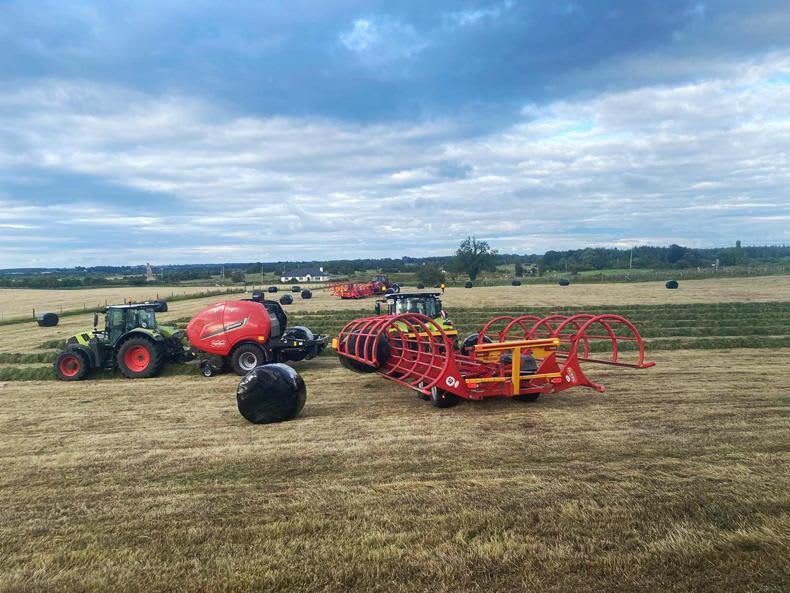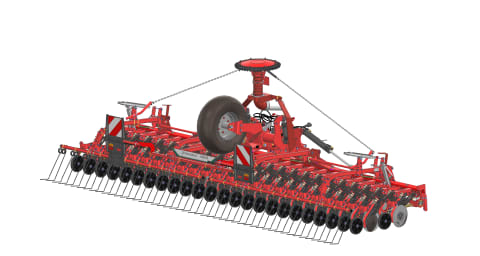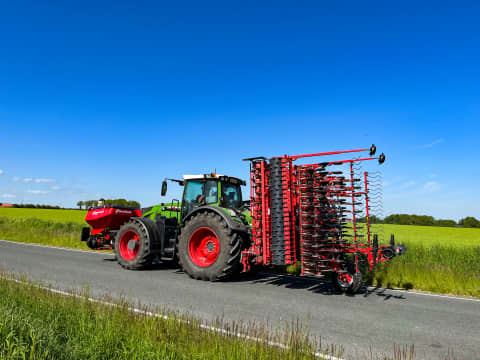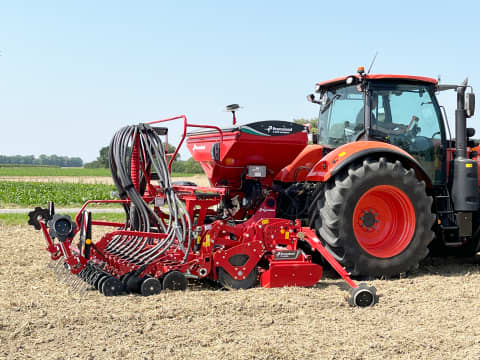Image Source: Irish Farmers Journal
Having worked with other contractors over the years, Sean started off his own contracting business with a used round baler and a locally built Roco wrapper. These were pulled with a 2WD Belarus 860 and a 2WD Zetor 7011. Speaking about his outfit in the early years, Sean joked that the gear was good in those years, when he knew no better.
Kverneland FastBale
Last spring, Sean travelled down to Kilkenny to look at a new trailed sprayer he was buying. While there, he laid eyes on a Kverneland FastBale for the very first time. He said it was love at first sight. He ended up studying it closely and was impressed with what he saw.
While he was there, one of the salesmen Sean had been dealing with for over 30 years came over to walk him through the machine. He got a price and took delivery of the new baler just ahead of the 2024 silage season.
How does non-stop baling work?
The FastBale features two bale chambers. One is a full-sized main chamber and the other is known as a pre-chamber which is about two-thirds the size of the main chamber. The baling process starts the same as any other baler, with the main chamber producing the first bale. Once the bale is fully formed, instead of stopping to apply the net, it diverts the crop flow to the pre-chamber. This allows the net to be applied to the bale in the main chamber, before it’s ejected onto the wrapper. When the pre-chamber is full, the incoming crop flow and pre-compressed crop are transferred into the main bale chamber to finish forming the bale.
“It sounds complicated, but the concept is actually simple and the machine isn’t as complex as you might think. But most importantly it works, and works very well,” said Sean.
Pickup
The FastBale has a 2.2m wide pickup reel. The five-tine bar reel has a cam track at both ends, which reduces cam loadings by 50%, leading to more durability. The guide wheels don’t need to be removed or folded for transport. The intake rotor has 50 hardened tines. Sean runs 25 knives in the baler, but uses the selectable knife floor — so has only 12 or 13 knives up at any one time.
“I really like the pickup on the FastBale. It’s literally built just like a forage wagon – it has a serious rotor, it’s 800mm in diameter.”
“It’s well able for difficult west of Ireland wet [hay/silage] which has been tedded and raked,” explained Sean.

Pull-out knife bank
FastBale Premium upgrades in recent years have included a new user-friendly interface and a customisable knife cassette system. The knife bank slides out to one side, making it extremely easy to sharpen the knives. The knife cassette system is hydraulically/electronically controlled, minimising change time. The complete knife exchange requires a three-step process with simple manual operation. The drop floor and knife cleaning are controlled by the software. The 25-knife SuperCut chopping system allows group selection of 6, 12, 13 or 25 knives.
“The pull-out knife bank is a great job, it’s easy to pull-out and you would be more inclined to sharpen the knives more regularly when it’s easy to do so... I’ve also been very impressed with the Kverneland knives – they chop well and are very strong,” said Sean.
Wrapping system
Once the bale is netted, it’s discharged from the chamber onto the wrapper. The wrapper is then raised, and twin satellites wrap the bale at up to 50rpm. The wraparound rear frame eliminates the risk of bales rolling off the wrapper on slopes. Bales are discharged by raising the rear roller. Wrap is replaced from the left-hand side. The FastBale can store 10 rolls of wrap.
Controls
Like most modern balers, the FastBale works fully automatically from start to finish. It comes with touchscreen Tellus Pro terminal. The screen shows real-time status of the baling process, including pre- and main chambers and the wrapper. Sean has built-in cameras on his machine, allowing him to keep a close eye on things. If baling dry crops, the wrapper can be raised and bales discharged directly out of the main chamber. The FastBale is ISOBUS compatible and can be operated on any ISOBUS-ready tractor without the need for a separate terminal.
Verdict
“I’ve been very impressed with the FastBale. I bought the machine without ever seeing it working. What I liked most before I bought it was the fact I had a few good conversations with Seamus Varley, the Mayo man who actually designed the machine for Kverneland. If I’ve ever had any queries or questions on the machine, he’s always on the other end of the phone. In fact, he’s coming out to me shortly to go through the machine for this year’s silage season. That offers great peace of mind.”
“The machine is well designed and is strongly built. The pick-up and feed system are very strong, and it works a treat. The two chambers have been completely trouble-free, and the wrapping system hasn’t missed a beat. I love the way when you pull into the field and start, you don’t stop at all. The bale transfer system is seamless, it’s a very smooth transition – there’s no slapping or banging.”
“Weighing in at close to 8t empty, it is a heavy machine, but the Claas Arion 650 is well fit for it. The machine has serious throughput potential, but with any machine I have I try not to drive them on too hard, I like to mind machinery and keep things right. Once I’m making a good solid bale of silage every sixty seconds, I’m happy with that. But you could push it a lot harder and pump them out a lot quicker. In straw for example, we have turned out 100 bales per hour.”
“I’ll upgrade the FastBale for another FastBale when the time comes,” concluded Sean.
This article is adapted from a longer original feature by Peter Thomas Keaveney, published in the Irish Farmers Journal.
Read the full version online at: https://www.farmersjournal.ie/machinery/farm-machinery/non-stop-baling-keeps-galway-contractor-moving-864290




